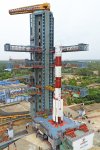Indian scientists at Ahmedabad's PRL discover EPIC new planet, 600 light years away
Indian scientists have discovered a new planet. With mass of about 27 Earth Mass and surface temperature of 600 degrees Celsius, the exoplanet revolves around a star some 600 light years away.
By India Today Web Desk, New Delhi
June 9, 2018, 18:09 IST
Indian scientists find new planet | Photo for representation: Lev Savitskiy via Getty Images
The scientific team of Physical Research Laboratory (PRL), Ahmedabad, has found a new planet.
The PRL team has found a sub-Saturn or super-Neptune size planet. The team was led by Professor Abhijit Chakraborty of PRL, Ahmedabad.
Main campus, Physical Research Laboratory (PRL), Ahmedabad | Photo from prl.res.in
The new planet has a mass of about 27 Earth Mass and size of 6 Earth Radii. The exoplanet was found around a Sun-like star and goes around the star in about 19.5 days.
The host star is about 600 light years away from the Earth.
According to the Indian scientists who found this new planet, the surface temperature of the planet is around 600 degrees Celsius given the fact that it is very close to the host star, which is to say that the new planet is 7 times nearer than the host star.
Planet size comparison of the newly discovered exoplanet and Earth | Photo from isro.gov.in
Even though its features make it inhabitable, the recent discovery is of importance.
The new planet and its discovery will help understand the formation mechanism of such super-Neptune or sub-Saturn kind of planets, that are too close to the host star.
SPECTROGRAPH :
The host star is about 600 light years away from the Earth.
The discovery of the new planet was made by measuring the mass of the planet using the indigenously designed
"PRL Advance Radial-velocity Abu-sky Search" (PARAS) spectrograph.
PARAS was designed and developed by the members of the Astronomy and Astrophysics Division of PRL | Photo from Mount Abu Infrared Observatory (prl.res.in)
PARAS spectrograph was integrated with a 1.2m telescope at PRL's Gurushikhar Observatory in Mount Abu, India. Only a few spectrographs that can do such precise measurements exist around the world and mostly are found in the USA and in the Europe.
Mount Abu Infrared Observatory | Photo from prl.res.in
PARAS is the first of its kind spectrograph in India. It can measure the mass of a planet going around a star and with this latest feat, India has joined the club of only a few countries that have discovered planets around stars.
HOST STAR EPIC 211945201 OR K2-236
The name of the host star around which the new planet was found is EPIC 211945201 or K2-236, hence, the planet will be known as EPIC 211945201b or K2-236b.
Initially, the source was found to be a planetary candidate from NASA K2 (Kepler2) photometry because it was transiting. This means, when the planet body comes in between the star and the observer on Earth as it goes around the star, it blocks a tiny amount of star-light.
This artist's concept depicts select planetary discoveries made to date by NASA's Kepler space telescope | Photo: W Stenzel/Nasa via REUTERS
By measuring the amount of light blocked by the planet body, the scientists can measure the diameter or size of the planet.
The Indian scientists at PRL, Ahmedabad, found the new planet K2-236b to be 6 Earth radii.
HURDLES AND PARAS SPECTROGRAPH
The PRL team met some hurdles along the way as they encountered calculations not sufficient to confirm the planetary nature of the system.
When they came across this problem, PARAS came to the rescue.
An independent measurement of the mass of the body was necessary for the discovery, which was made by the PARAS spectrograph.
The gravitational pull caused by a planet on its host star makes it wobble around their common centre of mass.
The gravitational pull shifts the spectra and can be measured in terms of Radial Velocity using precise and stabilised High Resolution Spectrographs, like the PARAS.
PARAS was designed and developed by the members of the Astronomy and Astrophysics Division of PRL | Photo from Mount Abu Infrared Observatory (prl.res.in)
The PRL scientists observed the target over a time-baseline of 420 days, which is to say in about 1.5 years, using the PARAS spectrograph for probing the nature of the system.
According to a Department of Space Indian Space Research Organisation
report, by measuring the amplitude of the teetering of the host star, the mass of the planet was found to be 27 Earth Mass.
The model shows the wobbling of the host star and its amplitude gives us the mass of the exoplanet K2-236b | Photo from isro.gov.in
Based on the mass and radius, model-dependent calculations suggest that the heavy elements, like ice, silicates, and iron content is 60-70 per cent of the total mass.
The latest discovery of the exoplanet by the PRL team was a result of 1.5 years studying and analysing the data and has indeed helped India showcase its excellence in the field.
SARASWATI
Last year, a team of Indian astronomers discovered a massive supercluster of galaxies. Saraswati - a supercluster of galaxies is as big as 20 million billion suns.
Supercluster of galaxies Saraswati discovered by Indian scientists | Photo from PTI
According to Pune-based Inter University Centre for Astronomy and Astrophysics (IUCAA), Saraswati is one of the largest known structures in the neighbourhood of the universe. It is 4,000 million light-years away from Earth and roughly more than 10 billion years old.
Indian scientists at Ahmedabad's PRL discover EPIC new planet, 600 light years away













































